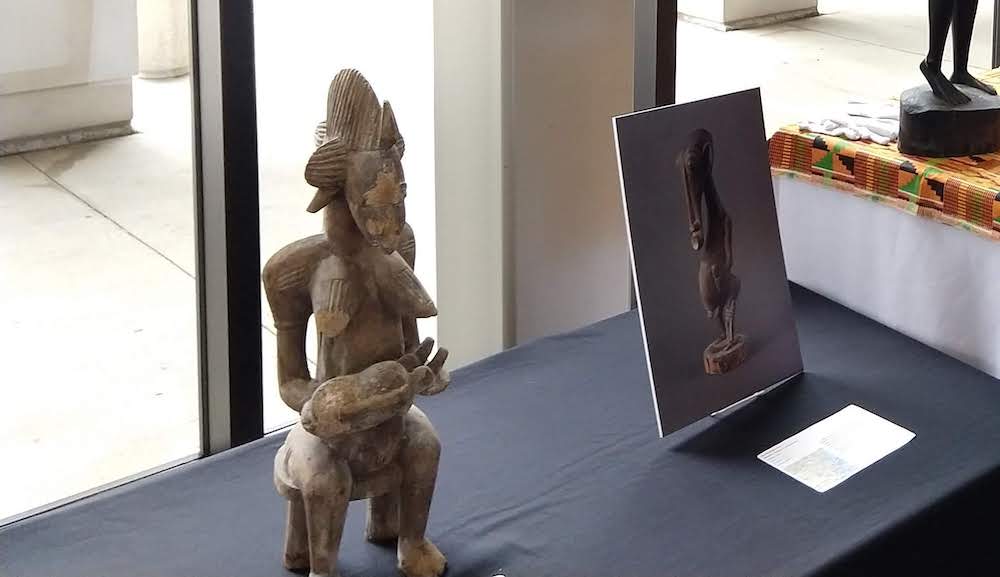"Dynamic Dimensions: Layered Meanings in African Art " exhibition in Buchanan Hall highlights parts of the Mason collection that have previously been kept in storage, faculty offices, and the Robeson Room
Though most students and faculty might not know this, George Mason University owns a substantial collection of art, including many significant and beautiful works of African Art. According to Director of Fellowships LaNitra Berger, most community members never see this art because it is scattered across campus and much of it is kept in storage that is inaccessible to students, faculty, and the public.

This Karan-Wemba mask is from the Mossi people of Burkina Faso. It honors deceased kings and the patterns on it represent religious codes and this culture's view of an ethical life.
In an effort to make these cultural resources known to the Mason community, Dr. Berger has been teaching an ARTH 495 course focused on creating an exhibition. Undegraduate and graduate students have worked throughout the Spring semester to research, present, and contextualize this work. The exhibit will be on display in the foyer of Buchanan Hall until April 29th.
At the opening event on Friday, April 12th, Dr. Berger explained the broader significance of starting a conversation about how we have valued this art in the past and how we ought to value it in the future, saying:
“It is important for people to understand that the issues of museums are not confined to the museum, but are important for our whole society: colonialism, injustice, and how we typically think of the African continent as if it is place without culture.”
Dr. LaNitra Berger, Director of Fellowships and Honors College Faculty
Speaking at the opening, University Curator Don Russel spoke to the importance not just of displaying this work, but of creating a long term solution for its safe storage, noting that “we really don’t have adequate facilitates for the storage of art.” He suggested that events like this one could help the University achieve the goal of establishing a permanent museum where these pieces and others can safely kept and appreciated. While on a tour of the exhibit, Dr. Michele Greet, the Director of the Art History program, emphasized that because the art has not been on display and lacks a public catalog, far less research has been done on works like these than she would like.

Hannah Khan, a student curator, gives a tour explaining the work and the class to faculty and fellow students
Hannah Khan, one of the student curators, led a tour of the exhibition. She opened by explaining the questions that they had attempted to address, both as a class and through the exhibition: What is “African” art? How can curators display art from living cultures effectively and ethically? How can museums and galleries present the context necessary to do justice to the art?
Khan emphasized that putting art like this into a museum or gallery context is especially fraught: very often, the art was not intended to be displayed in this way. Instead, she said, this art generally had dynamic and many-layered purposes and meanings. She explained that the exhibit was broken into four subthemes: ceremonies, masquerades, women and warriors, and sculptural primacy. This last subtheme particularly made visible the ways that the gallery context could be at tension with the work’s intent: while this work is often intended to be seen from all angles and perspectives, preserving and safely displying the work required that curators provide two-dimensional representations of several of the pieces.
To help put these pieces in context, the student curators have often supplemented the fine art photographs of the work created by interns in the Mason gallery with archival photographs from ArtStor showing similar pieces in use, a map showing where on the continent it is from, and a detailed explanatory gloss to help audiences appreciate the cultural circumstances in which it was created.
Speaking on behalf of University Vice President of Compliance, Diversity, and Ethics Julian Williams, Associate Director Gillian Lancaster encouraged Dr. Berger’s students and the broader audiences who see the exhibit to understand that a “a project like this allows us to explore the problematic idea of ‘forgotten narratives,’” and to engage with the active traditions and vibrant cultures who create artworks like those on display.

Some of the pieces on display at the opening
